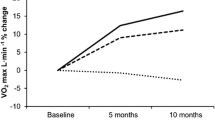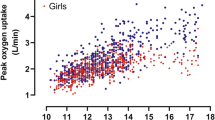Abstract
This study assessed the relationship between haemoglobin mass (Hbmass) and maximum oxygen consumption (VO2max) in adolescents over 1 year. Twenty-three subjects (11–15 years) participated; 12 undertook ~12 months of cycle training (cyclists) and 11 were sedentary (controls). Hbmass and VO2max were measured approximately every 3 months. At baseline there was a high correlation (r = 0.82, P < 0.0001) between relative VO2max (ml kg−1 min−1) and relative Hbmass (g kg−1). During 12 months there was a significant increase in relative VO2max of the cyclists but not the controls; however, there was no corresponding increase in relative Hbmass of either group. The correlation between percent changes in relative VO2max and relative Hbmass was not significant for cyclists (r = 0.31, P = 0.33) or controls (r = 0.42, P = 0.19). Training does not increase relative Hbmass in adolescents consistent with a strong hereditary role for Hbmass and VO2max. Hbmass may be used to identify adolescents who have a high VO2max.


Similar content being viewed by others
References
Ashenden MJ, Gore CJ, Burge CM, Clough ML, Bourdon PC, Dobson GP, Hahn AG (1999) Skin-prick blood samples are reliable for estimating Hb mass with the CO-dilution technique. Eur J Appl Physiol 79:535–537
Astrand P-O (1952) Experimental studies of physical capacity in relation to sex and age. Munksgaard, Copenhagen
Bouchard C, Daw EW, Rice T, Perusse L, Gagnon J, Province MA, Leon AS, Rao DC, Skinner JS, Wilmore JH (1998) Familial resemblance for VO2max in the sedentary state: the heritage family study. Med Sci Sports Exerc 30:252–258
Brotherhood J, Brozovic B, Pugh LGC (1975) Haematological status of middle- and long-distance runners. Clin Sci Mol Med 48:139–145
Burge CM, Skinner SL (1995) Determination of hemoglobin mass and blood volume with CO: evaluation and application of a method. J Appl Physiol 79:623–631
Cain SM (1995) Mechanisms which control VO2 near VO2max: an overview. Med Sci Sports Exerc 27:60–64
Clark SA, Bourdon PC, Schmidt W, Singh B, Cable G, Onus KJ, Woolford SM, Stanef T, Gore CJ, Aughey RJ (2007) The effect of acute simulated moderate altitude on power, performance and pacing strategies in well-trained cyclists. Eur J Appl Physiol 102:45–55
Craig NP, Norton KI, Bourdon PC, Woolford SM, Stanef T, Squires B, Olds TS, Conyers RAJ, Walsh CBV (1993) Aerobic and anaerobic indices contributing to track endurance cycling performance. Eur J Appl Physiol 67:150–158
Eastwood A, Hopkins WG, Bourdon PC, Withers RT, Gore CJ (2008) Stability of hemoglobin mass over 100 days in active men. J Appl Physiol 104:982–985
Glass HI, Edwards RHT, De Garetta AC, Clark JC (1969) CO red cell labeling for blood volume and total hemoglobin in athletes: effect of training. J Appl Physiol 26:131–134
Gledhill N, Warburton D, Jamnik V (1999) Haemoglobin, blood volume, cardiac function, and aerobic power. Can J Appl Physiol 24:54–65
Gonzalez-Alonso J, Richardson RS, Saltin B (2001) Exercising skeletal muscle blood flow in humans responds to reduction in arterial oxyhaemoglobin, but not to altered free oxygen. J Physiol 530:331–341
Gore CJ, Hahn AG, Burge CM, Telford RD (1997) VO2max and haemoglobin mass of trained athletes during high intensity training. Int J Sports Med 18:477–482
Gore C, Craig N, Hahn A, Rice A, Bourdon P, Lawrence S, Walsh C, Stanef T, Barnes P, Parisotto R, Martin D, Pyne D (1998) Altitude training at 2,690 m does not increase total haemoglobin mass or sea level VO2max in world champion track cyclists. J Sci Med Sport 1:156–170
Gore CJ, Bourdon PC, Woolford SM, Ostler SM, Eastwood A, Scroop GC (2006) Time and sample site dependency of the optimized CO-rebreathing method. Med Sci Sports Exerc 38:1187–1193
Green HJ, Sutton JR, Coates G, Ali M, Jones S (1991) Response of red cell and plasma volume to prolonged training in humans. J Appl Physiol 70:1810–1815
Hansen L, Klausen K (2004) Development of aerobic power in pubescent male soccer players related to hematocrit, hemoglobin and maturation. A longitudinal study. J Sports Med Phys Fitness 44:219–223
Heinicke K, Wolfarth B, Winchenbach P, Biermann B, Schmid A, Huber G, Friedmann B, Schmidt W (2001) Blood volume and hemoglobin mass in elite athletes of different disciplines. Int J Sports Med 22:504–512
Hero M, Wickman S, Hanhijarvi R, Siimes MA, Dunkel L (2005) Pubertal upregulation of erythropoiesis in boys is determined primarily by androgen. J Pediatr 146:245–252
Hirsch GL, Sue DY, Wasserman K, Robinson TE, Hansen JE (1985) Immediate effects of cigarette smoking on cardiorespiratory responses to exercise. J Appl Physiol 58:1975–1981
Hopkins WG (2000) Measures of reliability in sports medicine and science. Sports Med 30:1–15
Howley ET, Bassett DR Jr, Welch HG (1995) Criteria for maximal oxygen uptake: review and commentary. Med Sci Sports Exerc 27:1292–1301
Hsia CC (1998) Respiratory function of hemoglobin. N Engl J Med 338:239–247
Kanstrup I-L, Ekblom B (1984) Blood volume and hemoglobin concentration as determinants of maximal aerobic power. Med Sci Sports Exerc 16:256–262
Kjellberg SR, Rudhe U, Sjöstrand T (1949) Increase of the amount of hemoglobin and blood volume in connection with physical training. Acta Physiol Scand 19:146–151
Klesges LM, Klesges RC, Cigrang JA (1992) Discrepancies between self reported smoking and carboxyhaemoglobin: an analysis of the second national health and nutrition survey. Am J Public Health 82:1026–1029
Leger LA, Mercier D, Gadoury C, Lambert J (1988) The multistage 20 m shuttle run test for aerobic fitness. J Sports Sci 6:93–101
Lilienthal JL Jr (1950) Carbon monoxide. Pharmacol Rev 2:324–354
Lilienthal JL Jr, Pine MB (1946) The effect of oxygen pressure on the uptake of carbon monoxide by man at sea level and at altitude. Am J Physiol 145:347–350
Martino M, Gledhill N, Jamnik V (2002) High VO2max with no history of training is primarily due to high blood volume. Med Sci Sports Exerc 34:966–971
Parisotto R, Wu M, Ashenden MJ, Emslie KR, Gore CJ, Howe C, Kazlauskas R, Sharpe K, Trout GJ, Xie M (2001) Detection of recombinant human erythropoietin abuse in athletes utilizing markers of altered erythropoiesis. Haematologica 86:128–137
Pearson TC, Guthrie DL, Simpson J, Chinn S, Barosi G, Ferrant A, Lewis SM, Najean Y (1995) Interpretation of measured red cell mass and plasma volume in adults: Expert Panel on Radionuclides of the International Council for Standardization in Haematology. Br J Haematol 89:748–756
Prommer N, Schmidt W (2007) Loss of CO from the intravascular bed and its impact on the optimised CO-rebreathing method. Eur J Appl Physiol 100:383–391
Remes K (1979) Effect of long-term physical training on total red cell volume. Scand J Clin Lab Invest 39:311–319
Roughton FJW, Root WS (1945) The fate of CO in the body during recovery from mild carbon monoxide poisoning in man. Am J Physiol 145:239–251
Rowland T, Kline G, Goff D, Martel L, Ferrone L (1999) One-mile run performance and cardiovascular fitness in children. Arch Pediatr Adolesc Med 153:845–849
Safrit MJ (1990) The validity and reliability of fitness tests for children: a review. Pediatr Exerc Sci 2:9–28
Saltin B, Calbet JA (2006) Point: in health and in a normoxic environment, VO2max is limited primarily by cardiac output and locomotor muscle blood flow. J Appl Physiol 100:744–745
Sawka MN, Convertino VA, Eichner ER, Schnieder SM, Young AJ (2000) Blood volume: importance and adaptations to exercise training, environmental stresses, and trauma/sickness. Med Sci Sports Exerc 32:332–348
Schmidt W, Prommer N (2005) The optimised CO-rebreathing method: a new tool to determine total haemoglobin mass routinely. Eur J Appl Physiol 95:486–495
Schmidt W, Prommer N (2008) Effects of various training modalities on blood volume. Scand J Med Sci Sports 18:57–69
Tomkinson GR, Olds TS (2007) Pediatric fitness: secular trends and geographic variability. Karger, Basel
von Dobeln W, Eriksson BO (1972) Physical training, maximal oxygen uptake and dimensions of the oxygen transporting and metabolizing organs in boys 11–13 years of age. Acta Paediatr Scand 61:653–660
Wagner PD (1996) Determinants of maximal oxygen transport and utilization. Annu Rev Physiol 58:21–50
Wagner PD (2006) Counterpoint: in health and in normoxic environment VO2max is limited primarily by cardiac output and locomotor muscle blood flow. J Appl Physiol 100:745–747
Wehrlin JP, Marti B (2006) Live high-train low associated with increased haemoglobin mass as preparation for the 2003 world championships in two native European world class runners. Br J Sports Med 40:e3
Wehrlin JP, Zuest P, Hallen J, Marti B (2006) Live high-train low for 24 days increases hemoglobin mass and red cell volume in elite endurance athletes. J Appl Physiol 100:1938–1945
Williams C (1995) Haemoglobin—is more better? Nephrol Dial Transplant 10(suppl 2):48–55
Acknowledgments
Sincere thanks to Grant Tomkinson for the provision of VO2max percentiles for adolescents. We would also like to thank Julie Hill and Nick Herlihy for their assistance with data collection. This study was jointly funded by the South Australian Sports Institute and the National Elite Sports Council Australia.
Author information
Authors and Affiliations
Corresponding author
Rights and permissions
About this article
Cite this article
Eastwood, A., Bourdon, P.C., Withers, R.T. et al. Longitudinal changes in haemoglobin mass and VO2max in adolescents. Eur J Appl Physiol 105, 715–721 (2009). https://doi.org/10.1007/s00421-008-0953-x
Accepted:
Published:
Issue Date:
DOI: https://doi.org/10.1007/s00421-008-0953-x




